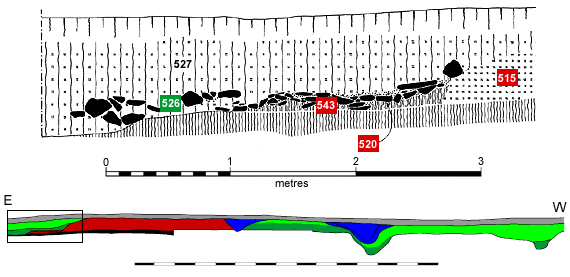View context list | View plan | View whole section | View section key | All sections

Figure 31: Intra-mural walkway. Section 6, Area 2
View context list | View plan | View whole section | View section key | All sections

Period 1 - The rear of the clay bank [515] is to the right, here with no remains of a turf revetment. Behind (to the left of) the bank lies a layer of closely packed flat stones, the intra-mural walkway [543]. This is laid on material which is darker than the subsoil under the bank, and interpreted as undisturbed turf.
Period 2 - A few of the stones contained within the lower part of the layer of earthy clay [526] immediately overlying the intra-mural walkway are probably derived from a wall at the rear of the bank, partially collapsed in the period of abandonment of the defences, period 2B.
Period 3 - The rest of the large and small stones overlying the walkway are probably from the destruction of this wall in period 3A. This is succeeded by another period of abandonment (period 3B) in which the bank degraded to form layer 527.
Period 4 - The absence of deposits which characterise this period at the front of the bank show that the back side of the original bank was not changed.
Compare section in similar position in Figure 28